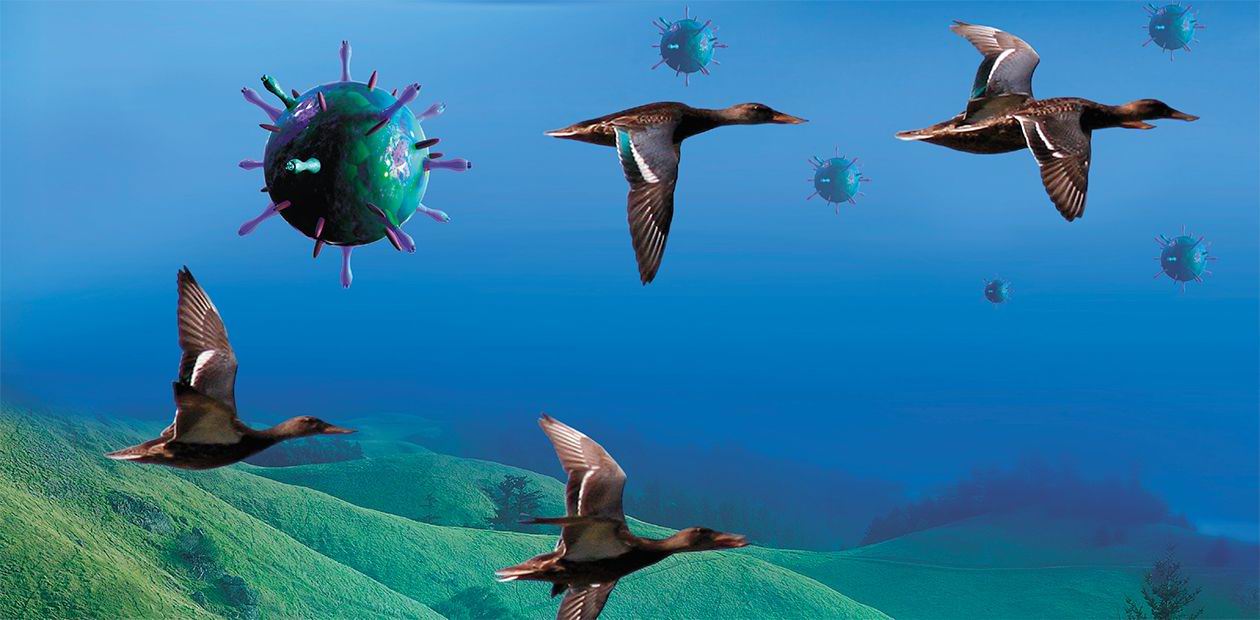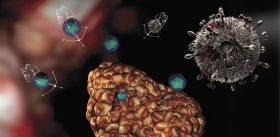Bird Flu, an Old Foe
“What have you to say about the fowls, Professor?” shouted Bronsky... He pointed a sharp, painted finger at an incredibly large headline which ran right across the whole page: “Chicken Plague in the Republic”. “The Fatal Eggs” by M. Bulgakov
For a long time the humankind has known the disease that in the 19th century was named “influenza”, or just “flu”, from Latin fluere, to flow. This unwanted companion of the humankind not only takes its yearly toll of epidemics but also causes mass deaths of birds, pigs, horses, and sometimes even minks and sea mammals. Flu is caused by viruses of the Orthomyxoviridae family: Influenza viruses A, B, and C. Their classification is based on so-called antigenic differences in their nucleoproteid and matrix proteins. Antigens are substances that elicit the immune response of an organism in the form of specific antibody formation.
The B or C influenza viruses affect only humans. The most pathogenic is influenza A, which will be discussed further. It can infect various species of animals, causing periodic devastating pandemics in the human population. The influenza A virus can be divided into subtypes based on two different proteins located on the surface of the virus, hemagglutinin and neuraminidase. We know sixteen subtypes of hemagglutinin and nine subtypes of neuraminidase. However, out of 144 possible pairs of combinations only 86 exist, and 83 of them were found among the flu viruses infecting birds. As far as the mammals are concerned, comparatively few virus subtype combinations were isolated. Only viruses of three subtypes of hemagglutinin (H1, H2, and H3) and two subtypes of neuraminidase (N1 and N2) widely circulate among people.
Natural reservoir
The influenza A virus was first isolated about 100 years ago. Since 1961 the virus has been isolated from at least 90 species belonging to 12 orders of birds in North America, Europe, India, Japan, South Africa, and Australia. The virus was found in more than a quarter of 149 species of the order Anseriformes and in about 20 species of the order Charadriiformes. Representatives of the latter (herons, plovers, terns, etc.) are spread worldwide and are noted for their long-distance migrations.
The flu virus in wild birds propagates mainly in the epithelial cells that line the gastrointestinal tract, and is excreted in high concentrations with faeces into the environment, including water, where it can stay active up to six months, depending on the conditions. Accordingly, the main way of transmission of infection is faecal-oral. It is remarkable that in the majority of cases the virus does not produce any visible signs of disease: the individuals are latent virus carriers. Obviously, such avirulent nature of infection in ducks and other waterfowl is a result of typical prolonged co-adaptation of the parasite and its host.
Thus, the primary reservoir for almost all subtypes of the influenza A virus is various birds of the Anseriformes and Charadriiformes orders. Other species do not play such a great role in the natural history of the flu viruses as these migrating birds living near water.
As a result of studying the flu virus genotypes in different species of birds, it was found out that they evolved independently in Eurasia and America. Thus, the migration between these two continents (latitudinal migration) is unlikely to play any role in the evolution of the flu virus, whereas the birds who migrate longitudinally contribute significantly to the process.
The latest history
It is evident that during the centuries and millennia the bird flu virus “peacefully” circulated among animals, being one of the factors of natural selection and regulation of the population. However, with the development of agriculture and mass poultry farming, the virus faced “new prospects”. This was favored by both inevitable overcrowding of poultry and artificial selection aimed at increasing the productivity of individuals, which unavoidably leads to a decrease in their resistance. However, for a long time the problem of “bird flu” has been discussed only by virologists, veterinarians, and zootechnicians.
The situation changed in 1997, with the mass epizootic of “bird flu” in Hong Kong, which was caused by the influenza A virus, serotype H5N1. This event could have passed unnoticed by the global community. However, as it turned out, the same virus made 18 people ill, and six of them died. The only effective weapon to fight the infection sweeping through the poultry farms in Hong Kong was total slaughter of the birds. But the genie was out of the bottle, and in the following years the H5N1 flu virus began its spread over the countries of South East Asia and China, causing great economic losses.
Following the migration routes, in the fall of 2005 the virus rushed with the migrating birds to the Middle East, Northern Africa, and Southern Europe. That is how the epizootic of “bird flu” started to turn into a “panzootic”, crippling poultry farming in many countries and, moreover, threatening human health. The world community and mass media began to speak about the advent of a new “plague” of humankind.
The treacherous Spanish influenza and the Hong Kong killer
All of us in our life have encountered the disease that doctors diagnose as influenza. It has been established now that more often than not the primary source of the disease in humans is the descendants of that very viruses of “bird flu” that went through a very long evolution in human population, causing numerous epidemics and pandemics.
The first documented pandemic was the notorious Spanish flu, which arose from the H1N1 bird flu virus and killed 20 to 50 million people worldwide. A great number of victims died within the first few days of infection or as a result of complications provoked by the flu.
1957–1958. Asian influenza killed about a million people. In just five months it “covered” half the world, reaching the American continent.
1968–1969. Hong Kong flu again claimed about a million lives. The serotype of the virus that caused it, H3N2, is still circulating in the human population.
All these pandemics shared certain features. For example, the first outbreaks of the infections happened in Southeast Asia. The appearance of new flu viruses was accompanied by the disappearance of the viruses that had been circulating in the human population before. The reason for this phenomenon still remains unclear.
This is history. As for our time, let us return to the above-mentioned episode of poultry infection outbreaks in Hong Kong in 1997 and the accompanying human cases. All of them had high fever, gastrointestinal disorders, and hepatitis. The cause of death was the primary viral pneumonia.
These were just the first signs. According to WHO, from 2003 to February 2006, about 170 human cases of “bird flu” were officially registered with the death rate exceeding 50 %.
Serial killer wanted
The latest events had to put flu researchers on their guard. As the recurrence of human pandemics was about 30 to 40 years, then by the end of the last century the time was up. Who is the candidate for the next “serial killer”?
In the last decade, the low pathogenic subtypes H5 and H7 that circulated in wild waterfowl earlier have noticeably intensified their pathogenicity both to their natural host and to other bird and mammal species. Four new variants of the virus killing not only birds but also humans, namely, H5N1, H9N2, H7N7, and H7N3, have been found, the most common serotype being H5N1. This highly pathogenic Asian variant of “bird flu” continues to “conquer” the planet, widely spreading over the whole Europe and North Africa. Among its victims, besides innumerable poultry, are the local people.
But how great is the chance of a new pandemic of flu arising? Yes, the virus of “bird flu” has become more virulent and has generally overcome the bird–human interspecific barrier. Nevertheless, it still cannot be transmitted directly from human to human and spread quickly among people, which is the requirement for a pandemic to appear. However, this can occur if a “proper” exchange of the genetic material is made say, between, H5N1 strain and a strain of human influenza virus, which may happen if a human or an animal contracts both human and bird flu at the same time.
Theoretically, such viral descendants might obtain hereditary combinations that would secure its effective transmission to the human population. Ordinary domestic pigs, our closest genetical and physiological relatives, can serve as a certain “mixing bowl” for the creation of a new pandemic virus. Fortunately, it has not happened yet; that is why the most urgent measures today are the development and realization of preventive biosafety control measures in the poultry industry, along with the continuing research into the virus ecology in its natural environment.
In the vast expanse of Siberia
Why did Siberian scientists, virologists and ornithologists, living and working far from Southeast Asia, took the problem of “bird flu” so close to their hearts? The reason is that the flyways of the birds wintering in different regions of the world — Europe, Africa, the Middle East, Central Asia, Hindustan, and Southeast Asia — merge here, in the south of West Siberia. Siberian lands, generously supplied with water, are a perfect place for nesting and resting of millions of birds.
Mass migrations of birds take place here from the end of March to the first half of June and from the second half of July to almost mid-October, with birds periodically crowding in some forest-steppe areas in the spring-fall period. The population of the nesting colonies of waterfowl can reach several thousands of individuals. All this ensures most favorable conditions for the spreading of various viral and other diseases dangerous for humans.
Since 2002, the State Research Center of Virology and Biotechnology VECTOR and the Institute of Systematics and Ecology of Animals, SB RAS, have been monitoring the “bird flu” virus in wild migrating birds on the area of the Novosibirsk region. For laboratory analysis samples (cloacal swabs) from netted live birds as well as from birds shot during the spring and fall hunting seasons, in the periods of mass migration, were taken.
Thirty samples out of 1120 taken from wild birds from 2002 to May 2005 contained various strains of the influenza virus, including the highly pathogenic H5N1. Carriers of the potential infection were different species of wild ducks, as expected.
In the laboratory of theoretical genetics of the Institute of Cytology and Genetics of the Siberian Branch of the Russian Academy of Sciences (SB RAS), a fundamentally new model of the mechanism with the help of which the influenza virus defends itself against the immune system of humans based on molecular modeling has been developed. One of the surface proteins of the virus, hemagglutinin, is able to form a “shield” of ions that hampers the antibodies’ attacks. Details will be covered in our upcoming issues in articles by V.A. Ivanisenko, candidate of biology, and N. A. Kolchanov, corresponding member of the Russian Academy of Sciences (Institute of Cytology and Genetics, SB RAS, Novosibirsk).
Since the fall of 2003 our scientists have extended the studies of the flu virus circulation in wild birds into the contiguous Mongolian areas. This is, however, only the beginning of a great research work. Our specialists have plans for North Siberia, where dozens and hundreds of millions of birds from Africa, Europe, Asia, America, and Australia come to nest in the vast lands from Taymyr to the Bering Sea every spring, and from where new variants of “bird flu” spread all over the world.
Every fall, people begin talking about the coming winter and the epidemic of influenza. They eagerly buy anti-flu medicines and get vaccinated in the futile hope not to fall ill or to speed up recovery. When the weather gets warmer and the spring comes, nothing changes, for in summer the morbidity peak shifts to the southern hemisphere. Even though influenza and the like are cured by themselves, some patients develop different complications. Not all of them are serious, but considering a great number of the diseased, every year the complications are deemed responsible for many deaths. Usually about 20% of the population contracts the disease, and the death rate among the contracted is 0.04 %. This is not much when predicting an outcome of a single case, but the world scale is impressive: for 6 billion of the population more than 500,000 people die!
Even more people die in epidemics. During 1918 “Spanish influenza” mortality was, supposedly, 2–3 %. If such a pandemic happens again today, about 70 million people will die, and in a relatively short time. In just half a year, the virus can occupy the whole world and take its mournful toll. Is the humankind ready for that? A tactics and strategy of fighting the probable pandemic will be covered in our next issues by V. V. Vlasov, doctor of medicine, director of the Russian Branch of the Nordic Cochrane Center (Moscow).
Photos presented in the article are by the courtesy of A. Yurlov (Institute of Systematics and Ecology of Animals, SB RAS, Novosibirsk)












